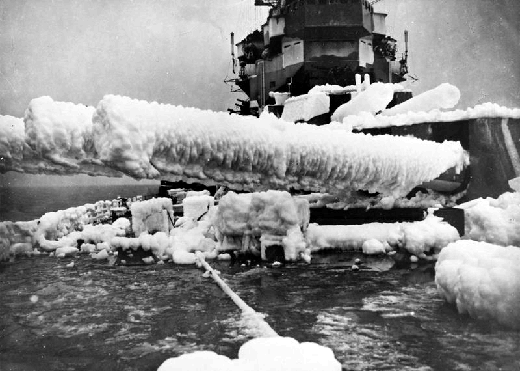Air Operations, Crete
IX Bomber Command B-25s attack several Axis airdromes.
[Air Operations, East Indies
90th Heavy Bomb Group B-24s attack the Kendari airfield on Celebes Island.
[Air Operations, Europe
BOMBER COMMANDEvening Ops:
- 21 Wellingtons lay mines between Brest and Texel. 2 Mosquitos are sent to Essen and Ruhrort.
Air Operations, New Guinea
3d Light Bomb Group A-20s attack Malahang.
[Air Operations, Solomons
- Cactus Air Force bombers and fighters attack the Munda Point on New Georgia.
- Late in the day, XIII Bomber Command B-26s escorted by XIII Fighter Command P-38s and P-39s, attack the Vila airfield on Kolombangara.
HMS Anson in the Arctic Ocean |
 |
Air Operations, Tunisia
- During the afternoon, XII Bomber Command bombers attack Kairouan Airdrome.
- 12th Air Force fighters strafe German Army machine-gun emplacements and trucks in and around Faid Pass, Axis-occupied buildings near Mezzouna, and trucks near Station de Sened.
Diplomatic Relations
In a letter to Stalin, Churchill, with characteristic optimism, forsees the end of the campaign in Africa by April, the conquest ot the Italian peninsula by July and the landing in France not later that August (1943, that is).
[Eastern Front
The Russians take Belgorod, north of Kharkov on the railway line to Kursk, and the small town of Shebekino to the southeast.
SOUTHERN SECTORUnits of the 40th Army capture Belgorod as 69th Army takes Volchansk and Shebekino. The advance of the 3rd Tank south of Kharkov is interrupted as the Germans move elements of the SS Panzer Corps to block its path.
The North Caucasus Front mounts its Krasnodar Offensive Operation with some 390,000 men. Its intention is to break down the 17th Army defenses around the town and puth the Germans back into the Taman peninsula.
[Guadalcanal
The 2nd Battalion, 161st Infantry, which has been traveling over the uphill north coast flank on scanty rations, goes into regimental reserve. The 1st Battalion passes through the 3rd Battalion at Doma Cove and takes over the assault followed closely by the 3rd Battalion and the Antitank Company. By afternoon, the 1st Battalion has covered 5 miles, crosses the Tenamba River and enters village of Tenaro.
Col George F. Ferry's force starts around Cape Esperance toward the same objective, the village of Tenaro, a point selected by Lt-Col Paul A. Gavan for forces to meet. Advancing in column of companies they meet some fire from Japanese machine guns and mortars but do not halt. Moving beyond the range of 75-mm pack howitzers they use their mortars for support. Between 1600 and 1700 the 2nd Battalion, 132nd Infantry, marches into Tenaro meeting the 1st Battalion, 161st Infantry, an event that marks the end of organized fighting on Guadalcanal. Only scattered stragglers from Japanese 17th Army remain on the island. At 1630 Gen Patch sends a message to Adm Halsey announcing the 'total and complete defeat of Japanese forces on Guadalcanal.'
While the Americans can feel justly elated over the end of Japanese resistance on Guadalcanal, about 13,000 of the enemy have been allowed to evacuate. The western pursuit was executed too slowly to achieve its purpose, the complete destruction of the enemy. On January 15 Hyakutake had received the evacuation order from Gen Hitoshi Imamura. The 17th Army began evacuating the night of January 22. Rescuing destroyers ran down the Slot to Esperance 3 times to evacuate troops: the nights of February 1, 4, and 7th. The Japanese were evacuated to Buin and Rabaul.
The cost of the Guadalcanal fighting: More than 60,000 Army and Marine Corps ground forces deployed; 1st Marine Division: 774 killed, 1962 wounded; the Americal Division 334 killed, 850 wounded; 2nd Marine Division, 268 killed, 932 wounded; 25th Divisione, 216 killed, 439 wounded. More than 36,000 Japanese from the 17th Army and the Special Naval Landing Forces fought on Guadalcanal. 14,800 were killed or missing, 9,000 died of disease and about 1,000 taken prisoner.
In the campaign the Japanese have lost about 10,000 killed to the Americans' 1,600. The losses in ships and planes have been about equal but in effect this favors the Americans. Strategically it has been a major Japanese defeat, but only a fraction of the Japanese army has been involved, and, judging by their resistance, the next American campaigns will be very hard indeed. The Americans are now masters of what is for practical purposes a huge, unsinkable aircraft carrier for the protection of Australia, the recapture of the Solomons and the following thrust north across the Pacific. Well satisfied, Gen Patch is at last able to send the following message to Adm Halsey: 'Total and complete defeat of Japanese forces on Guadalcanal effected 16:25 today... Am happy to report this kind of compliance with your orders... "Tokyo Express" no longers has terminus on Guadalcanal.' The sufferings have been tremendous but they have brought a priceless reward.
[Mediterranean
- The first of 7 troop convoys leave southern Italy with powerful reinforcements for Axis forces in Tunisia. These will continue until March 22. Malta-based RAF aircraft sink 10 of the ships. Specially laid minefields and British submarines also score numerous successes. 3 submarines will be lost.
- The British corvette Erica sinks on a mine off Benghazi with the loss of some of her seamen. All the officers and 71 seamen are rescued by the anti-submarine whaler Southern Maid.
North Africa
TUNISIAKesselring, Rommel and von Armin modify their attack plan because the Americans are withdrawing from Gafsa. Von Arnim is to attack Sidi Bou Zid followed up later with an attack in the Gafsa area by forces under Rommel.
[Pacific
The US submarine Tarpon (SS-175) sinks the Japanese transport Tatsuta Maru (16,974t) 42 miles east of Mikura Jima.
[